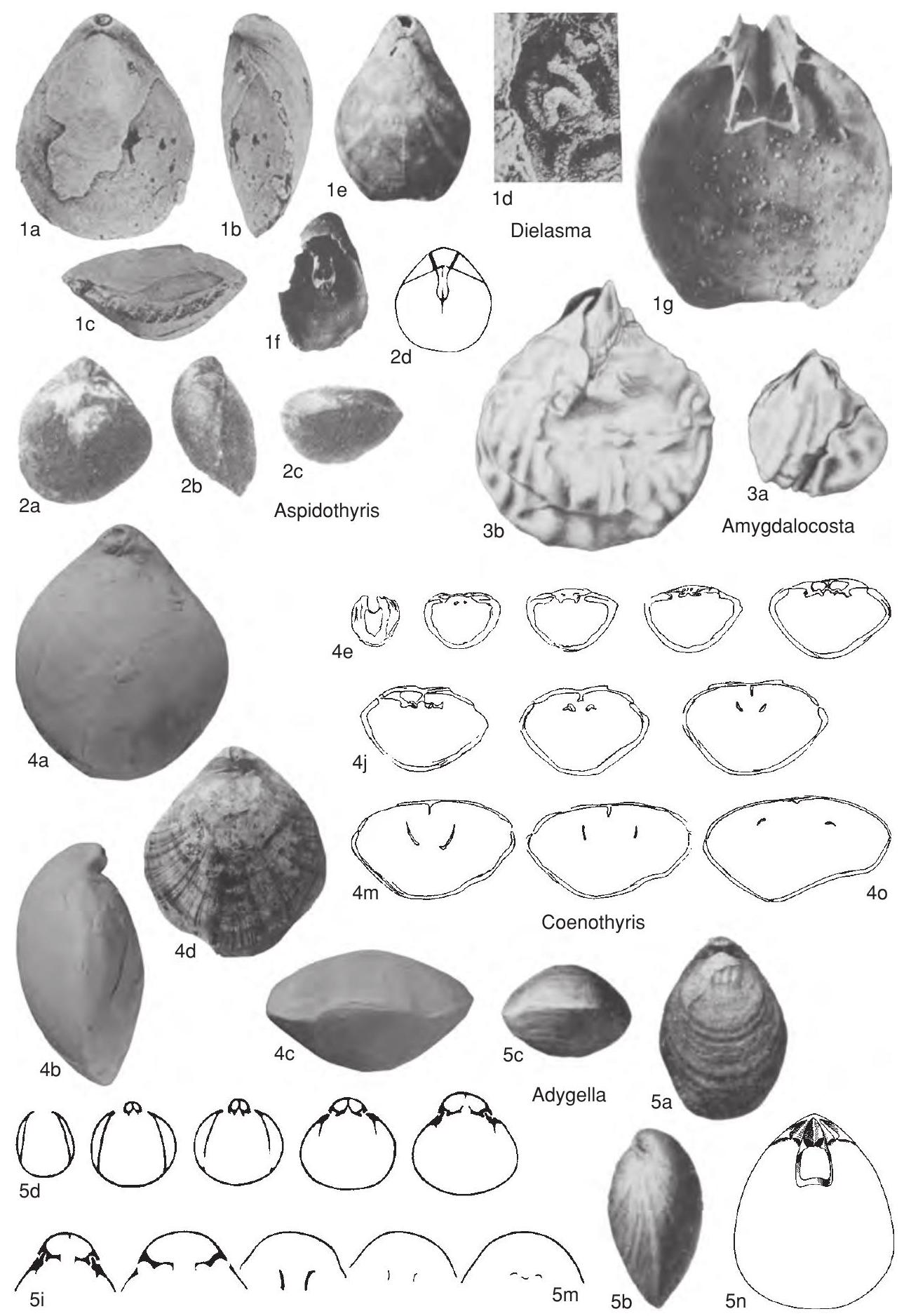Welcome to the Treatise on Invertebrate Paleontology!
Please enter a genera name to retrieve more information.

Coenothyris
Classification
Phylum:
Brachiopoda
Subphylum:
Rhynchonelliformea
Class:
Rhynchonellata
Order:
Terebratulida
Suborder:
Terebratulidina
Superfamily:
Dielasmatoidea
Family:
Dielasmatidae
Subfamily:
Dielasmatinae
Formal Genus Name and Reference:
Coenothyris DOUVILLÉ, 1879, p. 270
Type Species:
* Terebratulites vulgaris SCHLOTHEIM, 1820, p. 275, OD
Images
(Click to enlarge in a new window)
Fig. 1342, 4a-o. *C. vulgaris (Schlotheim), Muschelkalk, a-c, dorsal, lateral, and anterior views of topotype from Schlotheim's original collection, Germany, X1 (new, courtesy of the late A. S. Dagys), d, dorsal valve with characteristic color banding, Lagoubran, France, X1, e-0, transverse serial sections 1.2, 3.9, 4.8, 5.4, 7.0, 7.4, 7.7, 8.8, 10.8, 11.6, 16.0 mm from ventral umbo, Lagoubran, France, X1 (Hagdorn & Sandy, 1998).
Synonyms
Praerhaetina
Geographic Distribution
Europe, Afghanistan, Himalayas, China, Yugoslavia, Bulgaria, Israel
Age Range
Beginning Stage in Treatise Usage:
Middle Triassic
Beginning International Stage:
Anisian
Fraction Up In Beginning Stage:
0
Beginning Date:
246.7
Ending Stage in Treatise Usage:
Upper Triassic
Ending International Stage:
Rhaetian
Fraction Up In Ending Stage:
100
Ending Date:
201.36
Description
"Medium to large, elongate oval to subpentagonal in outline, biconvex, usually with prominent dorsal fold, anterior commissure uniplicate or rarely bisulcate, beak suberect or incurved, beak ridges angular, foramen permesothyrid, radiating color banding often present, pedicle collar present, dental plates short, may be fused with thickened shell wall, cardinal process broad, concave, outer hinge plates subhorizontal in section, median septum high, about 0.3 dorsal valve length, septalium present, adult loop deltiform with long crural processes, 0.3 dorsal valve length, transverse band fragile, rarely preserved."
References
Museum or Author Information
Classification
Phylum:
Brachiopoda
Subphylum:
Rhynchonelliformea
Class:
Rhynchonellata
Order:
Terebratulida
Suborder:
Terebratulidina
Superfamily:
Dielasmatoidea
Family:
Dielasmatidae
Subfamily:
Dielasmatinae
Formal Genus Name and Reference:
Coenothyris DOUVILLÉ, 1879, p. 270
Type Species:
* Terebratulites vulgaris SCHLOTHEIM, 1820, p. 275, OD
Images
(Click to enlarge in a new window)
Fig. 1342, 4a-o. *C. vulgaris (Schlotheim), Muschelkalk, a-c, dorsal, lateral, and anterior views of topotype from Schlotheim's original collection, Germany, X1 (new, courtesy of the late A. S. Dagys), d, dorsal valve with characteristic color banding, Lagoubran, France, X1, e-0, transverse serial sections 1.2, 3.9, 4.8, 5.4, 7.0, 7.4, 7.7, 8.8, 10.8, 11.6, 16.0 mm from ventral umbo, Lagoubran, France, X1 (Hagdorn & Sandy, 1998).
Synonyms
Praerhaetina
Geographic Distribution
Europe, Afghanistan, Himalayas, China, Yugoslavia, Bulgaria, Israel
Age Range
Beginning Stage in Treatise Usage:
Middle Triassic
Beginning International Stage:
Anisian
Fraction Up In Beginning Stage:
0
Beginning Date:
246.7
Ending Stage in Treatise Usage:
Upper Triassic
Ending International Stage:
Rhaetian
Fraction Up In Ending Stage:
100
Ending Date:
201.36
Description
"Medium to large, elongate oval to subpentagonal in outline, biconvex, usually with prominent dorsal fold, anterior commissure uniplicate or rarely bisulcate, beak suberect or incurved, beak ridges angular, foramen permesothyrid, radiating color banding often present, pedicle collar present, dental plates short, may be fused with thickened shell wall, cardinal process broad, concave, outer hinge plates subhorizontal in section, median septum high, about 0.3 dorsal valve length, septalium present, adult loop deltiform with long crural processes, 0.3 dorsal valve length, transverse band fragile, rarely preserved."
